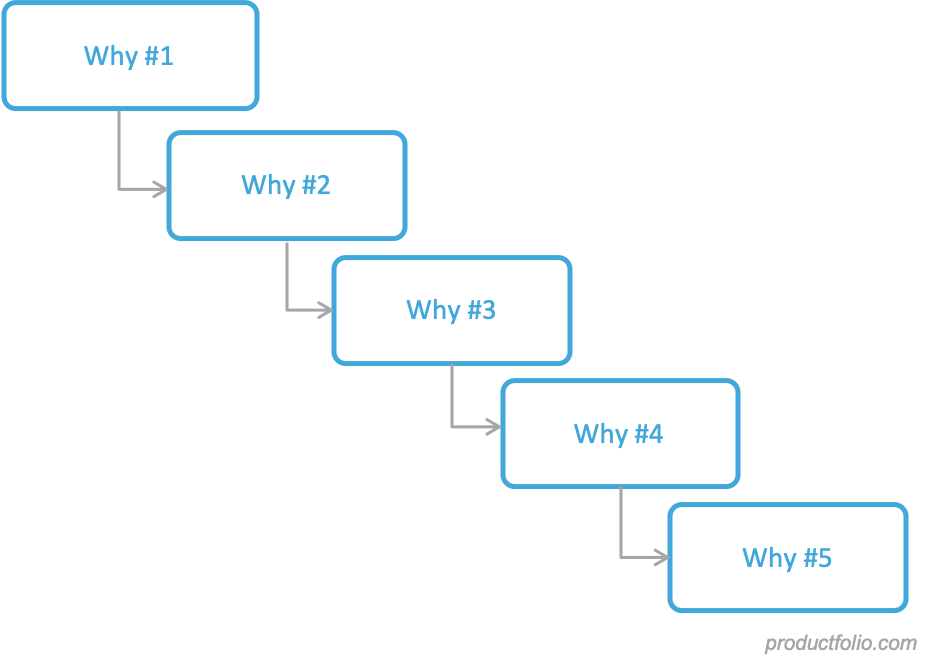What Are the 5 Whys?
The 5 Whys is an iterative interrogative approach to solving a problem, that explores cause and effect. Using the 5 Whys is like peeling an onion, every “Why” gets you closer to the core. It’s also like peeling an onion in that it can be painful to discover the core issue of the problem that you’re solving. The basic concept of the 5 Whys is that it takes asking the question “Why” 5 times before you arrive at the core problem that created the issue that was originally discovered.

Original Statement: I want to develop my own product.
Q1: Why?
A1: I will have control over my time and my workflow
Q2: Why do you want this?
A2: It will give me more flexibility and freedom
Q3: Why do you desire more flexibility?
A3 I can work from home and be my own boss
Q4: Why do you want to work from home?
A4: I will be able to spend more time with my kids
Q5: Why is this important for you?
A5: Family is my top priority
The five “whys” encourages you to dig deeper and go beyond an initial statement. You can see that the start of this statement is someone who has a job, and would like to develop their own product. By asking why three times you get to understand that they want to be their own boss, but that’s still not the whole picture. Once you ask “why” five times it becomes clear that having the time and financial freedom to support family is the underlying motivation for developing this product.There is not a hard and fast rule for the number of “Whys” that you should ask, the general consensus is that it takes approx 5 Whys.
Who Created the 5 Whys?
Toyota Motor company was the first to adopt the “5 Whys” as a regular practice in their manufacturing methodologies. The technique was originally created by Sakichi Toyoda who started the Toyoda family companies. Toyota was later established by his son, Kiichiro Toyoda.
Asking the 5 Whys is the basis of Toyota’s approach to the production line. At Toyota, the 5 Whys have become a critical component in problem-solving training.
When to use the 5 Whys?
Using the “5 Whys” is useful in any situation that you’re looking to get to the root cause of something. It’s also applicable whenever an answer is insufficient and you want to dig a little deeper.
Guidelines for the 5 Whys
Somethings online have hard and fast rules for the 5 whys, but really, this method should remain flexible with a few guidelines.
- Create an atmosphere of trust
- Pay attention to the logic of cause-and-effect
- Have a facilitator present if it’s a tough situation
- Ask Why until “human error” is no longer the root cause
- Distinguish causes from symptoms
- Be curious when asking “Why”, don’t jump to conclusions
- Ask “Why” until you get to the root cause
When asking the “5 Whys” its important to verify the answers that you’re receiving for accuracy before proceeding to the next “Why” question.
Criticism of the 5 Whys?
The 5 Whys are not black and white, and it’s important to take a look at the criticisms to avoid pitfalls when applying a method to your workflow. Some of the criticisms for the 5 Whys include stopping at the symptoms rather than going to lower-level root causes. It’s also been criticized that asking different people will get you different answers. Also, an inability to go beyond the investigators’ knowledge. Since the 5 Whys is not black and white and lives more in the grey area, it’s helpful when working with this method to have a flexible mindset.
In conclusion, to be human is to error. As long as humans are a part of the workflow, problems will arise. It’s imperative as a Product Manager to have ways of working through issues when they arrive, and the 5 Whys is an easy approach that helps to get to the core issue.


